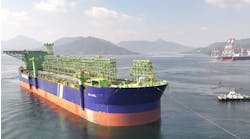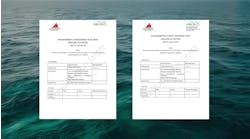Mooring line design rules re-calibrated to include 2000-meter water depths
Experience from offshore petroleum activities over the last half century has gradually been systemized in design codes for various types of offshore structures and structural components. As offshore activities continue to develop, by moving into deeper water and utilizing new materials, the question arises whether these design codes are still applicable. This question is being addressed for mooring line design, in the joint industry Deepmoor project.
Structural reliability methods are being used to extend a design code, such that the same reliability is attained over a range of water depths from 70 meters to 2000 meters. This design code forms a part of Det Norske Veritas' rules for mobile offshore units, and is known as Posmoor.
The basic idea in reliability-based calibration is that a design code should lead to designs with the same reliability, throughout the scope of applicability of the code. The reliability is quantified in terms of the annual probability of failure, or an equivalent reliability index. Reliability is usually not mentioned in design.
Perhaps the closest thing is the factor of safety. But this is a much less robust measure of the adequacy of a design.
In general, there is no guarantee that application of the same factor of safety will cause different designs to have the same reliability. Relia bil ity analysis can be used to guide modifications to a design code, such that the objective of consistent reliability is attained. The heart of a reliability based calibration of a design code is an iterative process where the design code is gradually modified, a set of test systems is designed according to the design code, and the reliabilities of the resulting designs are computed. The iteration is complete when the design code produces designs that are as close as possible to the target probability of failure.
Limit states
The basic design criteria are expressed in terms of limit state functions. Three limit state functions are included in the mooring line design code:
- An ultimate limit state (ULS) to ensure that the individual mooring lines have adequate strength to withstand the load effects imposed by extreme environmental actions.
- An accidental limit state (ALS) to ensure the mooring system has adequate capacity to withstand the failure of one mooring line, failure of one thruster, or one failure in the thruster system, for unknown reasons.
- A fatigue limit state (FLS) to ensure the individual mooring lines have adequate capacity to withstand cyclic loading.
Target reliabilities
Only the ULS and ALS are discussed in this article. Two consequence classes are defined in the modified Posmoor code. The 1st consequence class is typical for drilling rigs, while the 2nd consequence class is typical for floating production units. In consequence class 1, the target reliability for the ULS is set at the level defined by current design practice for drilling rigs, as reflected by the 1989 version of Posmoor.
The target reliability for the ALS is not based on existing practice, but is set on a comparative basis. This is intended to differentiate more effectively between the performance of various mooring line arrangements after the initial loss of a line, without causing a general increase in line dimensions. In consequence class 2, the target probability of failure is reduced by a factor of 10. This factor is typical of the difference between targets for other types of structures with comparable differences in the consequences of a failure.
The main change concerns the format of limit state functions. The present code includes only a single safety factor that is applied to the total line tension. The modified format defines two tension components, with a separate partial safety factor for each component. The two components are:
- TC-mean: The characteristic mean line tension, due to pretension and mean environmental actions in a short-term environmental state
- TC-dyn: The characteristic dynamic line tension induced by low-frequency and wave-frequency environmental actions in a short-term environmental state.
This change allows the design code to take account of the increasing importance of the mean tension component, with increasing water depth. This tension component is determined relatively accurately, and requires a lower partial safety factor than the dynamic tension. Thus, the modified code avoids excessively conservative designs for deepwater, and leads to more consistent reliability levels.
Other changes include:
- Application of a contour to define combinations of significant wave height and peak wave period to be checked. This ensures that low-frequency response is better taken into account.
- Minor modifications to the recipe for combination of low-frequency and wave-frequency components, to be more similar to API RP 2SK.
- An opening to use statistics for the actual breaking strength of mooring line components instead of the nominal, minimum breaking strength.
Application example
A drilling unit is considered as an example for the application of the proposed code modifications. This is a semisubmersible with 8 chain lines, made up from 90 mm NV R4 stud chain. The water depth is 500 meters and the horizontal distance from anchor to fairlead is 1398 meters. The mooring lines are uniformly spread. The minimum breaking strength of the chain is 8167 kN. The following environmental conditions are applied in the extreme load analysis:
The results of the design checks with the present code with the proposed modified rules are shown in the accompanying tables. Since this is a drilling unit, the lines may be designed to consequence class 1 for extreme conditions, while consequence class 2 only has to be satisfied under operating conditions, which are not shown here.
The mooring line design for this drilling platform satisfies both the present and the modified code. The ULS is critical with the present code, while the ALS is critical with the modified code. The margin between design strength and design tension is somewhat larger with the modified code.
The hearing process for the modified code is planned to take place during this autumn. Dependent on the results of the hearing process, the modified code may go into force in January 2000. Work is also underway on the extension of the scope to include synthetic fiber mooring lines. These results will be incorporated in the next revision.
Acknowledgements
This article is a summary of a paper based on results from the joint industry project, "Reliability-based, cost-effective, design methods for deepwater mooring systems," or Deepmoor. The entire paper plus additional graphic material, and a complete list of references is available from the author:
Tel: (47) 67-57-99-00; Fax: (47) 67-57-99-11; Web: www.dnv.com.
Also, the author acknowledges the support of the Deepmoor project participants: Advanced Production and Loading, Bridon International, Conoco Norge, Det Norske Veritas, the Health and Safety Executive, Lloyd's Register, Norsk Hydro, Norske Shell, the Norwegian Maritime Directorate, the Norwegian Shipowners' Association, the Royal Norwegian Research Council, Scana Ramn


